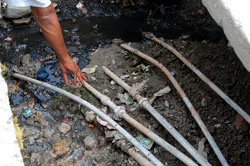|
|
Everywhere else in the world, as living standards rise typhoid makes a retreat. Not in Nepal. Contaminated food and water as well as drug resistance is turning the disease into a dangerous national epidemic.
Every monsoon sees a spike in typhoid cases because of leaky water mains. Every year 120 in every 10,000 Nepalis get the disease-which means a whopping 324,000 people fall sick every year for at least two weeks each. Even though the mortality rate is low, the loss to the economy is incalculable.
"When we went to the doctor he said I was sick because I drank dirty water but we drink water from the spout-the water there comes from an underground source so we figured it was clean," says Akash Magar, 18, a garment factory worker in Lagankhel.
In 1997, about 300 typhoid patients were treated at Patan Hospital, last year that figure jumped to 1,200 cases. While some of that is due to increased population, it also shows that water contamination is a chronic problem. "We have not been successful at spreading awareness about this disease," says Amit Arjyal a typhoid researcher at the hospital, "it is embarrassing that we are stuck with a disease like typhoid that is so easy to avoid."
Indeed, awareness and vaccination can prevent infections. Since the water mains will continue to be contaminated with faecal matter, people will have to keep boiling or treating drinking water and be careful about washing salads and fruits in tap water. In Europe and the US where typhoid cases are negligible, the disease is now known as 'VFR' (visiting friends and relatives) because it is mainly people of Nepali or Indian origin who are returning from vacations that fall sick.
Once diagnosed, patients are usually easily treated with antibiotics such as Ciprofloxacin which usually take effect within three days. However, left untreated the fever may continue for weeks or months and as many as 20 percent of sufferers die from complications. But doctors note an alarming increase in the resistance of the typhoid bacteria to antibiotics because over the years patients have been popping pills without consulting doctors.
 Aryal's research team at Patan Hospital is studying typhoid prevalence, natural immunity and treatment with alternative antibiotics. But doctors say that the best way to reverse the typhoid tide would be a massive public health campaign. Since dirty water is to be blamed for all typhoid cases, the focus should be on hygiene they say.
Aryal's research team at Patan Hospital is studying typhoid prevalence, natural immunity and treatment with alternative antibiotics. But doctors say that the best way to reverse the typhoid tide would be a massive public health campaign. Since dirty water is to be blamed for all typhoid cases, the focus should be on hygiene they say.
"Typhoid has been neglected. It is HIV, malaria and TB that get all the attention," says Buddha Basynat, a consultant at Patan Hospital. "Yet anyone from a minister to a porter can get it and every Nepali has been sick from it."
The problem is that the water and sewage pipes run side-by-side under Kathmandu's streets and both are leaky. In the monsoon, it is easier for the mains water to be contaminated with bacteria. "We can't wait for the pipes to be fixed, so what do we do till then? We have to work on personal hygiene though awareness," Basnyat stresses.
In the small room housing eight people, Akash Magar is now joined by his 15-year-old brother, Nikhil, who has also been diagnosed with typhoid. They sit together for breakfast, sipping water between bites. The water is still neither boiled nor treated.
Say the boys: "It is too expensive to boil water, we will start doing it when we have some money."
Avoiding typhoid
. boil drinking water or treat it with chlorine
. eat foods that have been thoroughly cooked
. soak fruits and salads in iodine before eating them
. wash your hands with soap and water before and after a meal



